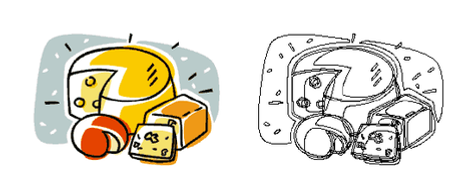Art Specifications
You want your logo and message on a product, and we're here to make sure you get what you want. Here's what we need from you to make the process go as smoothly as possible. If you're not the graphic designer, share this page with her or him. If you read this page and find your eyes glazing over, we'll be happy to help you prepare your artwork—for free or for a low fee, depending on the complexity. Contact us to get an estimate.
Here is the main takeaway for most artwork: Vectors are better than pixels. There are exceptions, such as when we'll be reproducing a photo, but for the grand majority of the work we do, remember: Vectors are better than pixels.
Here's a quick visual tutorial that explains the difference:

Artwork created with vectors can be stretched to any size without losing clarity or resolution. The vectors are outlines (shown on the right) filled with color. The edges are smooth and clean, and produce a clear image when printed.

Artwork created with pixels (such as this photograph, or any graphic made for websites) will break down if it's enlarged. The edges turn ragged, and produce a blurry image when printed larger than its original size, or if the original resolution is lower than 300 dpi at 100% size.
Below are the formats that will yield the best results. If you don’t see your format here, or have any questions, please contact us.
DIGITAL IMAGE FORMATS
We can accept the following image formats:
-
Vector EPS from Adobe Illustrator (up to the latest version) or CorelDraw. Note that importing a pixel graphic (like TIFF or JPEG) into Illustrator or Corel does not make it a vector graphic. All fonts should be converted to outlines. Also, just because a file has a .EPS extension does not mean it's a vector file. When in doubt, ask your designer or send us the file for a free review.
-
Vector PDF (with no security in the file). These files are generated from Illustrator or CorelDraw. All fonts should be converted to outlines. As with EPS files, just because a file has a .PDF extension does not mean it's a vector file. When in doubt, ask your designer or send us the file for a free review.
-
TIFF (usually 300 to 600 dpi at 100% size)
-
JPEG (usually 300 to 600 dpi at 100% size)
-
BMP (usually 300 to 600 dpi)
-
We can also accept files from the following programs (please be sure to include all supporting files—including screen and printer fonts and imported images):
-
Adobe Illustrator (up to latest version)
-
Adobe Photoshop (up to latest version)
-
Adobe InDesign (up to latest version)
We cannot accept Microsoft Powerpoint, Publisher, or Word documents as artwork.
ABOUT WEB GRAPHICS
Generally, images used on a web page are 72 dpi. They are so low in resolution because a computer screen has a relatively low resolution compared to the printed page. We can not use these graphic files for printing. However, in most cases, we can re-create from scratch a design to a usable vector format. Artwork that requires multiple revisions are subject to additional charges.
TEXT
Text sent as a computer file is preferred, as it will save the time and expense of us re-entering the text. This is most important for things like awards (names can easily be misspelled), and imprints with lots of text, like magnets and tip-in pages. We can accept almost any major word processing format, though Microsoft Word or Rich Text Format (RTF) are best.
SPOT COLOR VS. PROCESS COLOR
We were going to try to explain this, but we thought we'd defer to the experts on the subject: Pantone, which makes the inks. Click here for a short but thorough tutorial.